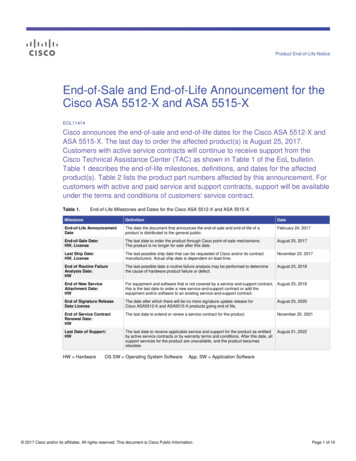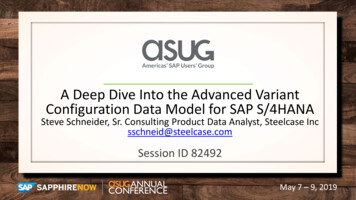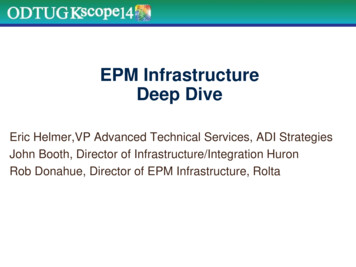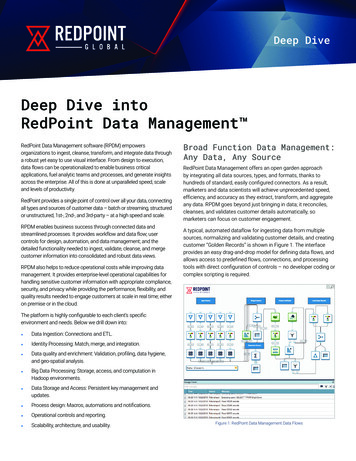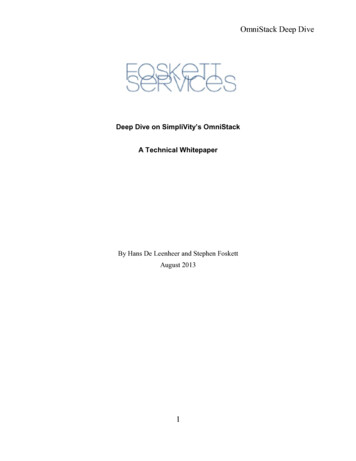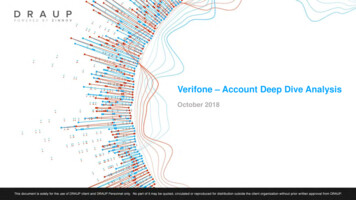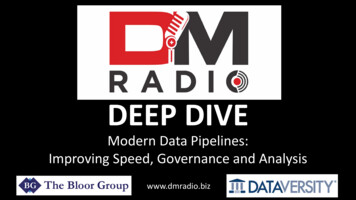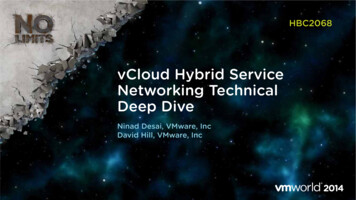
Transcription
ASA Clustering Deep DiveBRKSEC-3032Andrew OssipovTechnical Marketing Engineer
Your SpeakerAndrew Ossipovaeo@cisco.comTechnical Marketing Engineer8 years in Cisco TAC16 years in NetworkingBRKSEC-3032 2014 Cisco and/or its affiliates. All rights reserved.Cisco Public3
Agenda Clustering OverviewUnit Roles and FunctionsControl and Data InterfacesPacket FlowConfiguring ClusteringAdvanced Deployment ScenariosClosing RemarksBRKSEC-3032 2014 Cisco and/or its affiliates. All rights reserved.Cisco Public4
Clustering Overview
ASA Failover A pair of identical ASA devices can be configured in Failover––––––Licensed features are aggregated except 3DES in ASA 8.3 Data interface connections must be mirrored between the units with L2 adjacencyActive/Standby or Active/Active deployment with multiple contextsVirtual IP and MAC addresses on data interfaces move with the active unitCentralized management from the active unit or contextStateful failover “mirrors” stateful conn table between peers Failover delivers high availability rather than scalability– Cannot scale beyond two physical appliances/modules or virtual instances– Active/Active failover requires manual traffic separation with contexts– Stateful failover makes Active/Active impractical for scalingBRKSEC-3032 2014 Cisco and/or its affiliates. All rights reserved.Cisco Public6
ASA Clustering Up to 16 identical ASA appliances combine in one traffic processing system Preserve the benefits of failover––––Feature license aggregation across entire clusterVirtual IP and MAC addresses for first-hop redundancyCentralized configuration mirrored to all membersConnection state preserved after a single member failure Implement true scalability in addition to high availability––––Stateless load-balancing via IP Routing or Spanned Etherchannel with LACPOut-of-band Cluster Control Link to compensate for external asymmetryElastic scaling of throughput and maximum concurrent connectionsAll units should be connected to the same subnet on each logical interfaceBRKSEC-3032 2014 Cisco and/or its affiliates. All rights reserved.Cisco Public7
System Requirements All cluster members must have identical hardware configuration– Up to 8 ASA5580/5585-X in ASA 9.0 and 9.1; up to 16 ASA5585-X in ASA 9.2(1) – Up to 2 ASA5500-X in ASA 9.1(4) – SSP types, application modules, and interface cards must match precisely Each ASA5580/5585-X member must have Cluster license installed– Enabled by default on ASA5500-X except ASA5512-X without Security Plus– 3DES and 10GE I/O licenses must match on all members Limited switch chassis support for control and data interfaces– Catalyst 6500 with Sup32, Sup720, or Sup720-1GE and Nexus 7000 in ASA 9.0 – Catalyst 3750-X and Nexus 5000 in ASA 9.1(4) BRKSEC-3032 2014 Cisco and/or its affiliates. All rights reserved.Cisco Public8
Unsupported Features Auto Update Server– CSM 4.4 Image Manager feature still available Remote Access VPN– SSL VPN, Clientless SSL VPN, and IPSec DHCP Functionality– DHCP client, DHCPD server, DHCP Proxy, and DHCP Relay Advanced Application Inspection and Redirection– CTIQBE, WAAS, MGCP, MMP, RTSP, Scansafe, SIP, Skinny, H.323, GTP engines– Botnet Traffic Filter and WCCP Unified Communication Security– Phone Proxy, Intercompany Media Engine, and other TLS Proxy derivativesBRKSEC-3032 2014 Cisco and/or its affiliates. All rights reserved.Cisco Public9
Scalability Throughput scales at 70% of the aggregated capacity on average– 16 ASA5585-X SSP-60 at 20Gbps 224Gbps of Real World TCP Throughput– Scales at 100% with no traffic asymmetry between members Concurrent connections scale at 60% of the aggregated capacity– 16 ASA5585-X SSP-60 at 10M 96M concurrent connections Connections rate scales at 50% of the aggregated capacity– 16 ASA5585-X SSP-60 at 350K CPS 2.8M CPS Not all features are distributed, some are centralized– Control and management connections– DCERPC, ESMTP, IM, Netbios, PPTP, RADIUS, RSH, SNMP, SQLNet, SunRPC,TFTP, and XDMCP inspection engines– Site-to-site VPN– Multicast in some scenariosBRKSEC-3032 2014 Cisco and/or its affiliates. All rights reserved.Cisco Public10
Unit Roles and Functions
Master and Slaves One cluster member is elected as the Master; other are Slaves– First unit joining the cluster or based on configured priority– New master is elected only upon departure Master unit handles all management and centralized functions– Configuration is blocked on slaves– Virtual IP address ownership for to-the-cluster connections Master and slaves process all regular transit connections equally– Management and some centralized connections must re-establish upon Master failure– Disable or reload Master to transition the role; do not use cluster master commandBRKSEC-3032 2014 Cisco and/or its affiliates. All rights reserved.Cisco Public12
State TransitionLook for Master onCluster Control LinkMaster alreadyexistsElectionBootWait 45 seconds beforeassuming Master roleSlave Configand Bulk SyncMaster admits1 unit at a timeOn-CallReady topass trafficSlaveSync orhealth failureHealth failureMasterASA/master# show cluster history From StateTo StateReason 15:36:33 UTC Dec 3 2013DISABLEDDISABLEDDisabled at startup15:37:10 UTC Dec 3 2013DISABLEDELECTIONEnabled from CLI15:37:55 UTC Dec 3 2013ELECTIONMASTEREnabled from CLI BRKSEC-3032 2014 Cisco and/or its affiliates. All rights reserved.DisabledASA/master# show cluster infoCluster sjfw: OnInterface mode: spannedThis is "A" in state MASTERID: 0Version: 9.1(3)Serial No.: JAF1434AERLCCL IP: 1.1.1.1CCL MAC: 5475.d029.8856Last join : 15:37:55 UTC Dec 3 2013Last leave: N/ACisco Public13
Flow Owner All packets for a single stateful connection must go through a single member– Unit receiving the first packet for a new connection typically becomes Flow Owner– Ensures symmetry for state tracking purposesASA/master# show conn18 in use, 20 most usedCluster stub connections: 0 in use, 0 most usedTCP outside 10.2.10.2:22 inside 192.168.103.131:35481, idle 0:00:00, bytes 4164516, flags UIO Another unit will become Flow Owner if the original one fails– Receiving packet for an existing connection with no owner The conn-rebalance feature should be enabled with caution– An overloaded member may work even harder to redirect new connections– Existing connections are re-hosted only on unit departureBRKSEC-3032 2014 Cisco and/or its affiliates. All rights reserved.Cisco Public14
Flow Director Flow Owner for each connection must be discoverable by all cluster members–––––Each possible connection has a deterministically assigned Flow DirectorCompute hash of {SrcIP, DstIP, SrcPort, DstPort} for a flow to determine DirectorHash mappings for all possible flows are evenly distributed between cluster membersAll members share the same hash table and algorithm for consistent lookupsSYN Cookies reduce lookups for TCP flows with Sequence Number Randomization Flow Director maintains a backup stub connection entry– Other units may query Director over Cluster Control Link to determine Owner identity– New Owner can recover connection state from director upon original Owner failureTCP outside172.18.254.194:5901 inside192.168.1.11:54397, idle 0:00:08, bytes 0, flagsY– When Flow Director and Owner are the same, another unit has Backup Stub FlowTCP outsideBRKSEC-3032172.18.254.194:5901 inside192.168.1.11:54397, idle 0:00:08, bytes 0, flags 2014 Cisco and/or its affiliates. All rights reserved.Cisco Publicy15
Flow Forwarder All packets of the same connection may not always traverse a single unit– External stateless load-balancing mechanism does not guarantee symmetry– Only TCP SYN packets can reliably indicate that the connection is new Cluster member receiving a non-TCP-SYN packet must query Flow Director– No existing connection Drop if TCP, become Flow Owner if UDP– Existing connection with no Owner Become Flow Owner– Existing connection with active Owner Become Flow Forwarder Flow Forwarder maintains stub connection entry to avoid future lookups– Asymmetrically received packets are redirected to Owner via Cluster Control Link– Slave units become Flow Forwarders for any centralized connectionsASA/slave# show conn detail[ ]TCP inside: 192.168.103.131/52033 NP Identity Ifc: 10.8.4.10/22,flags z, idle 0s, uptime 8m37s, timeout -, bytes 0,cluster sent/rcvd bytes 25728/0, cluster sent/rcvd total bytes 886204/0, owners (1,255)BRKSEC-3032 2014 Cisco and/or its affiliates. All rights reserved.Cisco Public16
Control and Data Interfaces
Cluster Control Link (CCL) Carries all data and control communication between cluster members––––––Master discovery and initial negotiationKeepalives and interface status updatesConfiguration synchronization from Master to SlavesCentralized resource allocation (such as PAT/NAT, pinholes)Flow Director updates and Owner queriesCentralized and asymmetric traffic redirection from Forwarders to Owners Must use same dedicated interfaces on each member– Separate physical interface(s), no sharing or VLAN subinterfaces– An isolated non-overlapping subnet with a switch in between members– No packet loss or reordering; up to 10ms one-way latency in ASA 9.1(4) CCL loss forces the member out of the cluster– No direct back-to-back connectionsBRKSEC-3032 2014 Cisco and/or its affiliates. All rights reserved.Cisco Public18
CCL Best Practices Size and protect CCL appropriately––––––Bandwidth should match maximum forwarding capacity of each memberUse an LACP Etherchannel for redundancy and bandwidth aggregation20Gbps of Real World traffic with ASA5585-X SSP-60 2x10GE CCLDual-connect to different physical switches in vPC/VSSCannot use IPS- and CX-SSP expansion interfaces for CCLUse interface cards for extra 10GE ports in ASA 9.1(2) and laterVPCCCLCCL Set MTU 100 bytes above largest data interface MTU– Avoids fragmentation of redirected traffic due to extra trailer Ensure that CCL switches do not verify L4 checksums– TCP and ICMP checksums for redirected packets look “invalid” on CCLASA Cluster Enable Spanning Tree Portfast and align MTU on the switch sideBRKSEC-3032 2014 Cisco and/or its affiliates. All rights reserved.Cisco Public19
Data Interface Modes Recommended data interface mode is Spanned Etherchannel “L2”– Multiple physical interfaces of all members bundle into a single Etherchannelasa(config)# interface Port-Channel1asa(config-if)# port-channel span-cluster– Peer switch sees the cluster as a single logical entity– External Etherchannel load-balancing algorithm defines per-unit load– All units use the same virtual IP and MAC on each logical data interface Each member has a separate IP on each data interface in Individual “L3” mode– Use PBR or dynamic routing protocols to load-balance traffic– All Etherchannels are local to each member– Virtual IPs are owned by Master, interface IPs are assigned from configured poolsasa(config)# ip local pool INSIDE 192.168.1.2-192.168.1.17asa(config-if)# interface Port-Channel1asa(config-if)# ip address 192.168.1.1 255.255.255.0 cluster-pool INSIDEBRKSEC-3032 2014 Cisco and/or its affiliates. All rights reserved.Cisco Public20
Spanned Etherchannel Interface Mode Create transparent and routed firewalls on per-context basisMust use Etherchannels: “firewall-on-a-stick” VLAN trunk or separateUse symmetric Etherchannel hashing algorithm with different switchesSeamless load-balancing and unit addition/removal with cLACPVPC 1inside192.168.1.0/24ASA ClusterTe0/6Te0/8Te0/7Te0/9VPC 0/7Te0/9 2014 Cisco and/or its affiliates. All rights reserved.Cisco Public21
Clustering LACP (cLACP) Recommended way to bundle data interfaces into a Spanned Etherchannel– Up to 8 active and 8 standby links in 9.0/9.1 with dynamic port priorities in vPC/VSSasa(config)# interface Port-Channel 1asa(config-if)# port-channel span-cluster vss-load-balanceasa(config-if)# interface TenGigabitEthernet 0/8asa(config-if)# channel-group 1 mode active vss-id 1– Up to 32 active total (up to 16 per unit) links with global static port priorities in 9.2(1) asa(config)# cluster group DC ASAasa(cfg-cluster)# clacp static-port-priority– Use static LACP port priorities to avoid problems with unsupported switches– Always configure virtual MAC addresses for each Etherchannel to avoid instability– Disable LACP Graceful Convergence on adjacent Etherchannels in NX-OS cLACP assumes each Spanned Etherchannel connects to a single logical switch– LACP actor IDs between member ports are not strictly enforced, allowing creativityBRKSEC-3032 2014 Cisco and/or its affiliates. All rights reserved.Cisco Public22
Individual Interface Mode Routed firewalls onlyMaster owns virtual IP on data interfaces for management purposes onlyAll members get data interface IPs from the pools in the order of admittancePer-unit Etherchannels support up to 16 members in 9.2(1) inside192.168.1.0/24ASA ClusterTe0/6Te0/8Te0/7Te0/9.1 3Te0/7Te0/9SlaveBRKSEC-3032 2014 Cisco and/or its affiliates. All rights reserved.Cisco Public23
Traffic Load Balancing in Individual Mode Each unit has a separate IP/MAC address pair on its data interfaces– Traffic load-balancing is not as seamless as with Spanned Etherchannel mode Policy Based Routing (PBR) is very static by definition––––Use static route maps on adjacent routers to fan flows across all cluster membersSimple per-flow hashing or more elaborate distribution using ACLsDifficult to direct return connections with NAT/PATMust use SLA with Object Tracking to detect unit addition and removal Dynamic routing with Equal Cost Multi Path (ECMP)– Per-flow hashing with no static configuration– Easier to detect member addition and removal– Preferred approach with some convergence caveatsBRKSEC-3032 2014 Cisco and/or its affiliates. All rights reserved.Cisco Public24
Dynamic Routing Master unit runs dynamic routing in Spanned Etherchannel mode– RIP, EIGRP, OSPFv2, OSPFv3, and PIM; BGP4 by end of year– Routing and ARP tables are synchronized to other members like in failover– Slower external convergence only on Master failure Each member forms independent adjacencies in Individual mode––––Same protocols as in Spanned Etherchannel, but multicast data is centralized as wellHigher overall processing impact from maintaining separate routing tablesSlower external convergence on any member failureCreative designs are possible with “split” clusters Reduce protocol hello and dead timers on both sides to speed up convergenceasa/master(config)# interface GigabitEthernet0/0asa/master(config-if)# ospf hello-interval 1asa/master(config-if)# ospf dead-interval 2asa/master(config-if)# router ospf 1asa/master(config-router)# timers spf 1 1BRKSEC-3032 2014 Cisco and/or its affiliates. All rights reserved.Cisco Public25
Verifying Load Distribution Uneven Owner connection distribution implies a load-balancing issue– Use a more granular Etherchannel hashing algorithm on connected switches High Forwarder connection count implies flow asymmetry– Always match Etherchannel hashing algorithms between all connected switches– Cannot avoid asymmetry with NAT/PATCheck conn andpacket distributionasa# show cluster info conn-distributionUnitTotal Conns (/sec) Owner Conns (/sec) Dir Conns (/sec) Fwd Conns (/sec)A10010000B1600160000C10010000asa# show cluster info packet-distributionUnitTotal Rcvd (pkt/sec)Fwd (pkt/sec) Locally Processed (%)Avoid too 032 2014 Cisco and/or its affiliates. All rights reserved.Cisco Public26
Management Interface Any regular data interface can be used for managing the cluster– Always connect to virtual IP to reach the Master and make configuration changes– cluster exec allows to execute non-configuration commands on all membersasa/master# cluster exec show version include **************************Serial Number: *******************************Serial Number: JAF1511ABFT– Units use same IP in Spanned Etherchannel mode for syslog and NSEL Dedicated management interface is recommended to reach all units– management-only allows MAC/IP pools even in Spanned Etherchannel mode– Some monitoring tasks requires individual IP addressing (such as SNMP polling)– No dynamic routing support, only static routesBRKSEC-3032 2014 Cisco and/or its affiliates. All rights reserved.Cisco Public27
Health Monitoring CCL link loss causes unit to shut down all data interfaces and disable clustering– Clustering must be re-enabled manually after such an event Each member generates keepalives on CCL every 1 second by default– Master will remove a unit from the cluster after 3 missed keepalives (holdtime)– Member leaves cluster if its interface/SSP is “down” and another member has it “up”– Re-join attempted 3 times (after 5, 10, 20 minutes); then the unit disables clustering Each unit monitors the health of its interfaces only locally– Interface status (up or down) with 500ms reaction time– LACP bundling state with 9 second reaction time (no less than 45 seconds after join) You can disable CCL keepalives during changes or adjust the holdtime– Keepalive interval is always 1/3 of the configured holdtimeasa/master# cluster group sjfwasa/master(cfg-cluster)# no health-checkasa/master(cfg-cluster)# health-check holdtime 1BRKSEC-3032 2014 Cisco and/or its affiliates. All rights reserved.Cisco Public28
Packet Flow
New TCP ConnectionASA Clusterinsideoutside1. Attempt newconnection withTCP SYN6. UpdateDirectorClient2. Become Owner,add TCP SYN Cookieand deliver to ServerFlow Owner4. Redirect toOwner based onTCP SYN Cookie,become Forwarder5. Deliver TCP SYNACK to ClientServerFlow Director3. Respond with TCP SYNACK through another unitFlow ForwarderBRKSEC-3032 2014 Cisco and/or its affiliates. All rights reserved.Cisco Public30
New UDP-Like ConnectionASA ClusterinsideoutsideFlow Owner1. Attempt new UDPor another pseudostateful connection4. Become Owner,deliver to Server2. QueryDirectorClient3. Notfound5. UpdateDirector7. QueryDirector10. Deliverresponse to Client8. ReturnOwnerServerFlow DirectorFlow ForwarderBRKSEC-30329. Redirect toOwner, becomeForwarder 2014 Cisco and/or its affiliates. All rights reserved.6. Respond throughanother unitCisco Public31
New Centralized ConnectionASA Clusterinside1. Attempt newconnectionForwarder4. UpdateDirectorClientoutside2. Recognize centralizedfeature, redirect to Master,become ForwarderServerFlow Director3. Become Owner,deliver to ServerMasterBRKSEC-3032 2014 Cisco and/or its affiliates. All rights reserved.Cisco Public32
Owner FailureASA ClusterinsideFlow Owneroutside3. Next packetload-balanced toanother member6. Become Owner,deliver to Server4. QueryDirector5. AssignOwner7. UpdateDirectorClientServerFlow Director1. Connection isestablishedthrough the clusterBRKSEC-3032Flow Owner2. Owner fails 2014 Cisco and/or its affiliates. All rights reserved.Cisco Public33
Per-Session Port Address Translation (PAT) By default, dynamic PAT xlates have a 30-second idle timeout– Single global IP (65535 ports) allows about 2000 conn/sec for TCP and UDP ASA 9.0 Per-Session Xlate feature allows immediate reuse of the mapped port– Enabled by default for all TCP and DNS connectionsasa# show run allxlate per-sessionxlate per-sessionxlate per-sessionxlate per-sessionxlate per-sessionxlate per-sessionxlate per-sessionxlate any6any4any4any6any6any4any6any4a
–External Etherchannel load-balancing algorithm defines per-unit load –All units use the same virtual IP and MAC on each logical data interface Each member has a separate IP on each data interface in Individual “L3” mode –Use PBR or dynamic routing protocols to load-ba
